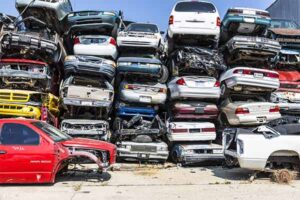GS3 – Environment

Context:
The Commission for Air Quality Management (CAQM) postponed the NCR-wide ban on fuel sales to End-of-Life Vehicles to 1 November 2025 due to operational challenges.
Definition of ELVs:
Vehicles deemed unfit due to age, structural damage, or failing fitness tests under the Motor Vehicles Act. As per CPCB, over 2 crore ELVs exist in India.
Ways a Vehicle Becomes an ELV:
- Fails automated fitness test.
- Registration cancelled under CMV Rule 52.
- Declared unfit by authorities or courts.
- Voluntarily surrendered by owner.
- Irreparable due to disasters.
Need for Regulation:
- Pollution Control: ELVs emit 12x more pollutants than BS-VI vehicles.
- Resource Recovery: 70% material recovery reduces raw material dependency.
- Energy & Emission Savings: 75% less energy and 58% less CO₂ through recycling.
- Environmental Protection: Informal dismantling leaks toxins into ecosystems.
- Road Safety: Reduces risk from mechanical failures.
Fuel Ban Details:
- Scope: Diesel vehicles >10 years; Petrol vehicles >15 years.
- Enforcement from: 1 Nov 2025 in select NCR districts; 1 Apr 2026 in rest.
- Tech Monitoring: ANPR cameras at fuel stations; VAHAN database integration.
Key Systems:
- ANPR Cameras: Real-time number plate scanning for automated fuel denial.
- VAHAN Database: Tracks vehicle age, registration, and fitness status.
ELV Disposal Framework:
- 75%+ ELVs dismantled in informal sector.
- AIS 129 (2015): National standard for safe vehicle dismantling.
- Scrappage Policy (2021): Mandates fitness testing; promotes private scrappage units.
- RVSFs: Authorised eco-friendly vehicle scrapping facilities.
- EPR (2025 Rules): Ties producers’ recycling responsibility to their market share.




